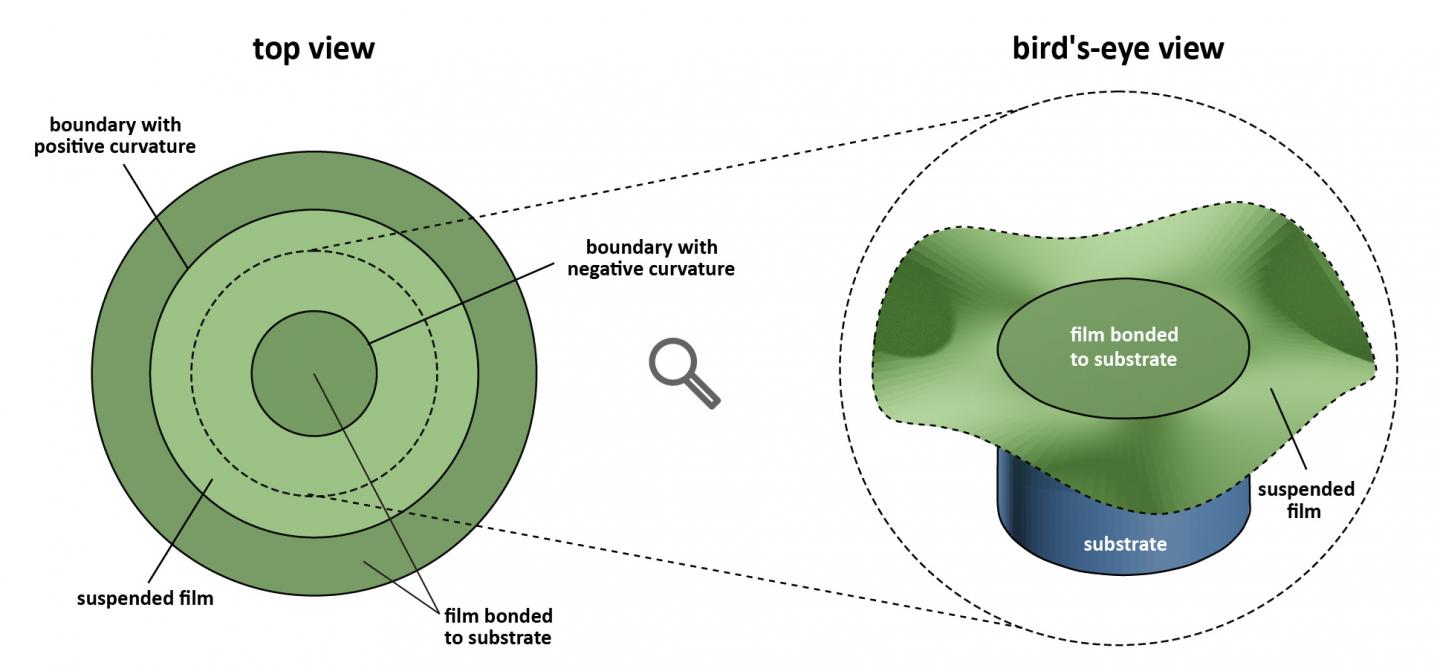Researchers combine experiments and theory to determine how curved edges affect the wrinkling of ultra-thin materials.

Credit: OIST
When we think of wrinkles, we usually envision the lines etched into our skin, for some an unwelcome reality and for others a proud sign of a life well-lived. In material science, wrinkles can also be either wanted or unwanted. But the physical factors that cause wrinkling to occur are not yet fully understood.
Now, in a paper recently published in Applied Physics Letters, researchers from the Mathematics, Mechanics, and Materials (MMM) Unit at the Okinawa Institute of Science and Technology Graduate University (OIST) have shown how wrinkles can be increased or reduced by altering the curvature at the edge of a material.
“Historically, scientists and engineers have focused on preventing wrinkling, which can adversely affect the performance of pressure sensors, aircraft panels, and lightweight spacecraft structures including deployable space booms and telescopes,” said Professor Eliot Fried, who leads the MMM unit. “But recent research has also shown that wrinkling can give materials useful properties. For example, it can be used to make a material super hydrophobic or to make coatings that reflect light in unique ways.”
Diamond windows of opportunity
The unit first encountered the phenomenon of wrinkling while working with ultra-thin nanocrystalline diamond films, grown on a sheet of glass.
“I was removing the layer of glass underneath small areas of the nanocrystalline diamond film to create diamond windows,” said Dr. Stoffel Janssens, first author of the study and postdoctoral researcher in the MMM unit. “Diamond windows are extremely difficult to make but they have really exciting potential applications, including being used as a transparent structure upon which a cell culture can be grown and easily visualized.”
The scientists found that wrinkling was an unavoidable part of fabricating diamond windows. The process of growing the nanocrystalline diamond film on top of the glass sheet involves heating and cooling the substrate, which causes the two layers to expand and contract by different amounts, generating stress in the layers, Dr. Janssens explained. Then, when a hole in the glass substrate is made by lasers and acids to form a diamond window, the residual stress causes the now suspended portion of nanocrystalline diamond film, which is no longer bonded to the sheet of glass, to deform and wrinkle around the edge.
“We realized that diamond windows provided a great opportunity to understand some of the physical factors that affect wrinkling,” said Prof. Fried. “Using circular diamond windows, we experimentally demonstrated the effect of diameter and boundary curvature on wrinkling, and then we also developed a simple theoretical model to explain what we observed.”
Bridging experiment and theory
In the study, the researchers created different sized diamond windows, and then measured the wavelength and number of wrinkles that formed in the suspended film around the curved edge of each diamond window.
They found that as the size of the diamond windows increased, reducing the curvature at the boundary between the bonded and suspended nanocrystalline diamond film, the density of wrinkles decreased, and the wavelength of each wrinkle was longer.
The researchers also measured the level of strain – the amount of deformation caused by the stress in the layers – across the diamond windows.
“Measuring strain across a 2D material in a conventional way is very complicated and expensive, but we were able to devise a technique where we instead determined the surface profile of the diamond window — how high each point is — and then developed algorithms to retrieve the strain values,” said Dr. Janssens.
The team then used the experimental results to develop a theoretical model, which they believe could be used to design devices with functional wrinkles or reduced wrinkling.
The model also expanded on the experiments, suggesting that devices containing a negative curvature would see further reductions in wrinkling.
Going forward, the unit are interested in creating diamond windows in the shape of rings, rather than circles. While more challenging to fabricate, these structures have two boundaries between the suspended and attached portions of nanocrystalline diamond films – one with positive curvature and one with negative curvature – allowing the scientists to use experiments to further explore the validity of their model.
“Overall, this study integrates theory, computation, experimentation, and analysis,” said Prof. Fried. “The interdisciplinary environment fostered at OIST made this work possible and has ultimately allowed all the researchers of our unit to collaborate and expand their expertise.”
###
Media Contact
Tomomi Okubo
[email protected]
Original Source
https:/
Related Journal Article
http://dx.





